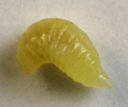Asteromyia
Asteromyia
Classification
- Phylum: Arthropoda
- Subphylum: Hexapoda
- Class: Insecta
- Order: Diptera
- Infraorder: Bibionomorpha
- Superfamily: Sciaroidea
- Family: Cecidomyiidae
- Subfamily: Cecidomyiinae
- Supertribe: Lasiopteridi
- Tribe: Alycaulini
- Genus: Asteromyia
Pronunciation
How to pronounce Asteromyia: //ˌæs.təˈroʊ.mi.jə//
These audio files are automatically generated. While they are not always 100% accurate, they are a good starting point.
Images






Summary
Asteromyia is a genus of gall midges found in North America, known for inducing blister galls predominantly on leaves and stems of Asteraceae plants. It consists of nine described species, with most associated symbiotically with fungi.
Physical Characteristics
Gall midges in the genus Asteromyia are small insects that induce gall formation on their host plants, primarily in the Asteraceae family. Full-grown larvae are typically encased in a hard, black cast formed by a fungal symbiont.
Identification Tips
Identification can be made through the observation of galls induced on Asteraceae plants, particularly the blister galls on leaves and green stems.
Habitat
Found primarily in North American habitats where Asteraceae plants are abundant, particularly areas with goldenrod and other composite plants.
Distribution
Distribution is specific to North America.
Diet
Feed primarily on plant tissue as larvae, causing galls to form on the host plants.
Life Cycle
The life cycle includes egg, larval, and pupal stages, with larvae inducing galls on the host plants while feeding.
Reproduction
Reproduction occurs through oviposition in suitable plant tissue, where the larvae will develop inside the galls.
Ecosystem Role
Asteromyia species play a role in their ecosystems by influencing plant health and dynamics through gall formation, which can affect nutrient cycling.
Collecting Methods
- Hand collecting galls from host plants
- Using sweep nets to capture adults around host plants
Preservation Methods
- Preserving specimens in ethanol
- Drying and mounting for taxonomic study
Similar Taxa
Misconceptions
Some might confuse Asteromyia with other gall-inducing flies that affect similar plants; however, each genus exhibits specific gall characteristics.
Tags
- Asteromyia
- gall midges
- Cecidomyiidae
- North America
- Asteraceae